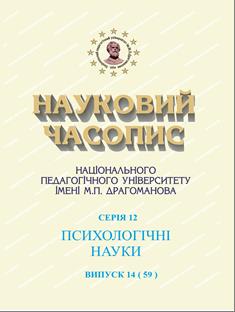PROJECTIVE APPROACH TO THE SOCIAL ADAPTABILITY RESEARCH
DOI:
https://doi.org/10.31392/NPU-nc.series12.2021.14(59).05Keywords:
adaptation, disadaptation, projective technique, geometric composition, social adaptabilityAbstract
Purpose: the article is devoted to theoretical research and proof of social adaptability existence as a personality property, its connection with adaptation and disadaptation, its research from the point of psychological approach, as well as empirical ways of searching quick recognition of adaptive ability decrease of young organism and psyche. Objectives: 1) to research theoretical approaches to social adaptability existence as a personality property, its connection with adaptation and disadaptation,
2) to explore scientific views on adaptability within the integrity paradigm, 3) to show emirically options to study adaptability using projective methods. Methods: theoretical methods were used, such as average qualitative indicators analysis, correlation analysis, namely, quantitative and qualitative analysis of adaptability indicators and projective methodology markers.
Results: theoretical analysis of different approaches to personality social adaptability and its links to adaptation and disadaptation was carried out. As a diagnostic tool, projective diagnostic methods were used, which allowed to quickly reflect the level and social adaptability indicators of the first-year student. Average values of general social adaptability were researched and their correlation with other adaptation disorders markers was confirmed. Quantitative and qualitative analysis between adaptability indicators and projective markers was performed. As a conclusion, we built up a model of fifteen factors, this research indicated that the predominance of some bright colours in the drawings corresponds to general adaptation increasing, orientation in society and reducing depression, as well as increasing emotionality. In its turn, the presence of monochrome colours shows an emotional increase and the state of health decrease. If a person uses hatching in drawings, this indicates a rigidity decrease. Some compositional figures highlight an increase in general adaptation and accuracy of social expectations orientation. The presence of such compositional principles like center, rhythm and proportions in the figures indicate an increase in general adaptation and satisfaction and decrease in disadaptation and depression. Conclusions: according to the research, we identified the role of social adaptability of a young person, investigated the phenomenon of adaptability using theoretical methods, and practically performed an experiment, using a projective technique.
References
- Babenko,P. (2013). Beseda o kompozicii s kinooperatorom V.P. Babenko, chlenom Sojuza kinematografistov SSSR i Ukrainy [Conversation about composition with the cameraman V.P. Babenko, the member of the Cinematographers Union of the USSR and Ukraine]. Odessa : Grin [in Russian].
- Berezin, F.B. (1988). Psihicheskaja i psihofiziologicheskaja adaptacija cheloveka [Mental and psychophysiological adaptation of a person]. Leningrad : Nauka [in Russian].
- Ershova-Babenko, I.V., Madinova Y.I. (2013). Innovacionnyj diagnosticheskij i korrekcionnyj instrument dlja psihologov: simptomokompleks kompozicionnoj organizacii risunka [The innovative diagnostic and correctional tool for psychologists: Symptomo-complex of the composite organization of the picture], Proceedings from Mezhdunarodnaya nauchno-prakticheskaya konferentsiya “Innovatsii i sovremennyie tehnologii v sisteme obrazovaniya” – International Scientific and Practical Conference “Innovations and Modern Technologies in Education” (Prague, February 20–21th, 2013). (pp. 204–206). Prague : Sociosféra-CZ [in Russian].
- Ershova-Babenko, I.V. (1992). Metodologija issledovanija psihiki kak sinergeticheskogo objekta [Methodology of mentality research as synergetic object]. Odessa : ODЕKOM [in Russian].
- Ershova-Babenko, I.V. (2005). Psihosinergeticheskie strategii chelovecheskoj dejatel’nosti. (Konceptual’naja model’) [Psycho-synergetic strategies of human activity. (Conceptual model)]. Odessa: NOVA KNYHA [in Russian].
- Kaznacheev, V.P. (1986). Adaptacija i konstitucija cheloveka [Human adaptation and constitution]. Novosibirsk : Nauka [in Russian].
- Madinova, Y.I. (2016). Osoblyvosti dezaptatsii studentiv-medykiv. [Particular qualities of disadaptation of students]. Candidate’s thesis. Odesa [in Ukrainian].
- Melnikova, N.N. (2006). Adaptivnye svojstva lichnosti: problemy izuchenija [Adaptive traits of personality: problems of study], Proceedings from Materialy mezhvuzovskoj nauchno-prakticheskoj konferencii «Social’naja psihologija segodnja: nauka i praktika» – Materials of the International Scientific and Practical Conference “Social psychology today: science and practice” (St. Petersburg, June 15th, 2006). Saint Petersburg : SPbGUP [in Russian].
- Nikiforov, G.S. (2003). Praktikum po psihologii menedzhmenta i professional’noj dejatel’nosti [Workshop on psychology of the management and professional activeness]. Saint Petersburg : SPbGUP [in Russian].
- Onoshko, E.S. (2009). Ponjatijnoe jadro teorii adaptacii: terminologicheskij aspekt [Conceptual issues of adaptation theory: terminological aspect]. Kemerovo : Vestnik KemGU [in Russian].
- Rean,A. (2006). Psihologija adaptacii lichnosti. Analiz. Teorija. Praktika [Psychology of personality adaptation. Analysis. Theory. Practice]. Saint Petersburg : Prajm-EVRO-znak [in Russian].
- Romm, M.V. (2002). Adaptacija lichnosti v sociume. Teoretiko-metodologicheskij aspekt [Personal adaptation in society. Theoretical and methodological aspects]. Novosibirsk : Nauka [in Russian].
- Sannikova, O.P. (2009). Adaptivnost’ lichnosti [Adaptability of person]. Odessa : Izd. N.P.Cherkassov [in Russian].
- Suhanov, A.A. (2011). Analiz ponimanija adaptacii cheloveka v otechestvennyh psihologicheskih issledovanijah [Analysis of the understanding of human adaptation in domestic psychological research]. Moscow : Gumanitarnyj vektor [in Russian].
- Rean, A.A., Konovalov I.A. (2020). Indicators of Parent-Child Relationships in the Context of Various Socio-Demographic Parameters. Integratsiya obrazovaniya. Integration of Education, 24(3), 433–452. https://doi.org/10.15507/1991-9468.100.024.202003.433-452
- Sannikova, O., Sannikov, O., & Husak, L. (2020). Features of deciveness in individuals with different emotional disposition. Georgian Med News, 301, 136–142. Retrieved from https://pubmed.ncbi.nlm.nih.gov/32535578/
- Seitova, A., Belov, G., Muratov, Z., Murzalieva, A., Abdullaeva, Z., Zhanbaeva, A., et al. (2021). Physiological, Anatomical, Psychological and Cultural-Ethnic Aspects of Indian Students Adaptation during Study in Kyrgyzstan Medical Universities. Open Journal of Medical Psychology, 10(1). https://DOI.org/10.4236/ojmp.2021.101001

